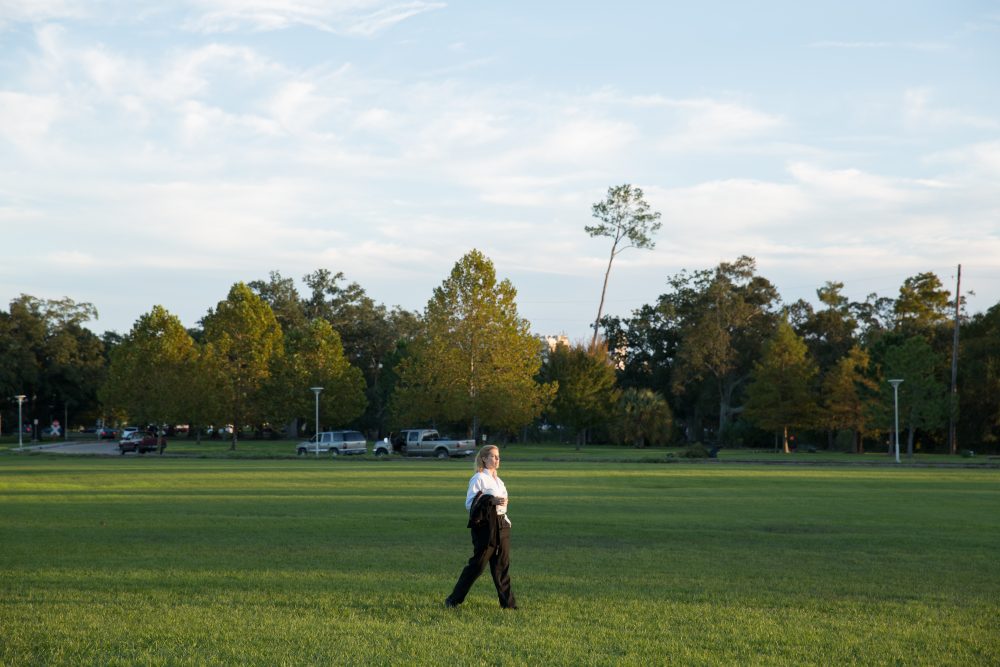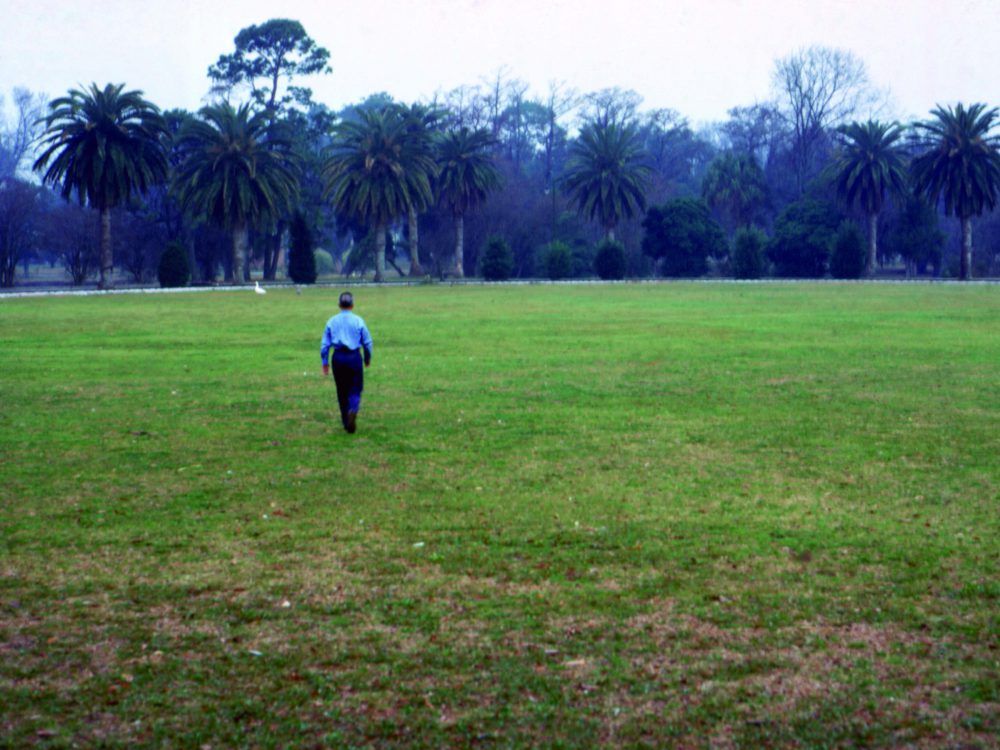Recuperating Lost Land: Dennis Oppenheim at the New Orleans Museum of Art
How should museums include historic works of performance art in their collections? Journalist Nathan C. Martin takes a closer look at a 1970 piece by Dennis Oppenheim.

Security guard Alexandria Harpigny performs Dennis Oppenheim’s Guarded Land at the New Orleans Museum of Art on November 20, 2015. Courtesy the New Orleans Museum of Art. Photo by Roman Alokhin.
In 1970, the New Orleans Museum of Art—then the Isaac Delgado Museum of Art—became the first art institution in the country to display a rock from the moon. The museum presented the rock not by itself—say, on a pedestal in an empty gallery—but surrounded by objects and artworks. Other museums soon followed suit. Newspaper reports of the time commenting on moon rock shows in New Orleans and elsewhere describe how underwhelming many of the rocks’ thousands of viewers found them. Perhaps people had hoped the rocks would crack open and birth an alien. Curators of moon rock exhibitions must have anticipated this response, because all across the nation they made sure patrons had other things to look at besides some dumb old rock from outer space.
At the New Orleans Museum of Art, curators surrounded the moon rock with earthworks—the show was called “Moon Rock and Earthworks.” Land Art had emerged as an exciting movement in the late 1960s, with energetic young men digging giant Vs into the forest ground, cutting trenches through thick lake ice, and creating images in fields one could discern only from aircraft. The same year the moon rock came to New Orleans, Robert Smithson unveiled Spiral Jetty, probably the world’s most famous piece of Land Art, in Utah’s Great Salt Lake. For his contribution to a seminal 1969 Earth Art exhibition at Cornell University, artist Richard Long undertook an “extensive search in a rock quarry near Ithaca” where he found “some dark gray schist.” He transported the stones in a station wagon and displayed them “in a rectangle on the sloping lawn in front of the museum.” If one follows the logic of Long’s effort, astronauts bringing a rock back from the moon and displaying it in a museum might have been the ultimate act of Land Art.
A few months ago—45 years after the “Moon Rock” exhibition—NOMA’s new Curator of Modern and Contemporary Art, Katie Pfohl, was leafing through file folders containing information about the museum’s permanent collection when she came across a couple that were empty. The files were simply labeled “Dennis Oppenheim.”
“They were just flapping in the breeze,” Pfohl said in a recent conversation. “No information, no pictures, no nothing.”
Upon further research, she learned that while much of the 1970 exhibition had consisted of photographs of prominent earthworks—including Walter de Maria's Mile Long Drawing and Claus Oldenburg's Placid Civic Monument—the museum had also commissioned Oppenheim to visit New Orleans and create a site-specific project. Oppenheim ended up contributing two pieces: For the first, he dug a massive pit in the swamp near the airport and, for the second, he had a security guard patrol the lawn outside the museum as a performance. The existence of the folders in the museum’s archives indicates that these works were considered part of its permanent collection. The fact that the folders were empty drives home the intrinsic impermanence of much of Oppenheim’s art from this period.
Oppenheim’s oeuvre is so vast and varied it confounds attempts at summary. In an essay accompanying a survey of his work published in 1992, curator Alanna Heiss wrote: “When we think of visionaries, we think of earthly ones, people who have their feet on the ground, but look far out into the unknown. Dennis has never had his feet on the ground; they’ve always been in the air. That’s why he made Earth Art.” But Oppenheim’s vision extended beyond using land as a medium. In the same year as “Moon Rock,” he made the first of his conceptual works using his own corpus—skin, blood, hair—what he would call Body Art. He then built elaborate machines that spit sparks and flames and others that performed absurd tasks. Even later, he incorporated puppets as a major element of his art and crafted large-scale, architectural sculptures. He often relied on dreams to inspire him.
Oppenheim never liked art museums much. For the same Cornell exhibition where Long made his rectangular arrangement of schist, Oppenheim transcribed the gallery’s dimensions onto the snowy ground outside, creating a “bird sanctuary,” where flocks would alight in various formations to partly comprise and complete the piece. He believed that art operated outside the museum’s walls, in the world, and that artmaking should be a perpetually active process. “A museum is not a place I am dying to visit in any city,” he told an interviewer. “My interest in art is in an art that is yet to be made.” When he arrived in New Orleans to create his commission, Oppenheim took one look at the photographs of earthworks on display at NOMA and disappeared into the swamp. He returned several days later, covered in mud, announcing his obligation fulfilled—he had dug a square pit, roughly 100 feet long on each side and six feet deep, delineated by fallen cypress trees. He called the artwork, which abutted the airport and was viewable from planes, Concentration Pit.
“I do kind of find it instructive that he went as far from the museum as he could to do his piece,” Pfohl said.
But NOMA officials confronted Oppenheim, reminding him he had agreed to create a site-specific work on the museum’s grounds. So the artist instructed a security guard to walk the lawn adjacent the museum as he would the floors of the galleries inside it. This work, which the artist named Guarded Land, critiqued the institutional authority of art museums, mocking the ways in which they coddle art and treat it as precious. A year later, Oppenheim would hone this idea by positioning 12 trained German Shepherd attack dogs to protect a vacant space outside the Museum of Fine Arts in Boston. The piece, Protection, was a “parody of the nearby museum, with its elaborate protection system for artworks. It was a condemnation of the museum as a place dedicated to an incorrect view of art as an eternal commodity to be sheltered from change and incursion,” critic Thomas McEvilley wrote.

Dennis Oppenheim, Guarded Land, 1970. Performance at the New Orleans Museum of Art.
So it might seem strange that, today, NOMA is eager to embrace what from the vantage of hindsight looks like Oppenheim giving the museum the finger. Pfohl and the museum have collaborated with the Oppenheim estate (the artist died in 2011) to unearth and amass documentation of Concentration Pit and Guarded Land to fill those once-empty file folders and substantiate NOMA’s claim on the works as part of its permanent collection. The museum has also arranged a reenactment of Guarded Land, with security officers treading the grounds in City Park in shifts each Friday afternoon, weather permitting, through January 22 (excluding Christmas and New Year’s Day). “I think the performance in really fascinating ways asks us to think about the relationship between interior and exterior space, institutional space, how we value land, how we think about relationships between people, and the role cultural institutions play in choosing what gets preserved and what gets left behind,” Pfohl said.
The Situationist International had a term for this kind of thing: recuperation. It’s the opposite of détournement, which is when a radical group hijacks expressions of institutional authority and turns them against the institutions—think of Adbusters using corporate imagery to criticize capitalism. Alternately, institutions can recuperate radical expressions for their own benefit—think of consumer products branded with Che Guevara’s image or major labels signing musicians who sing anti-establishment songs. By sanitizing Oppenheim’s critique of museums through the acquisition of archival, material objects, NOMA strips the art of its barbs. By promoting a critique of its institutional authority, the institution asserts its own authority.
“The idea of the hole in the ground seemed catalytic, certainly in the context that developed Earth Art, Land Art,” Oppenheim told an interviewer in the early 1990s. “It countered objectness, it countered permanence, it united the thing with the place. This one idea alone seemed to open the doors to an entire field, an entire vocabulary that made up the conceptual art domain…This radical agenda included thinking of an extreme alternative to the traditional system, an idea that had profound effects on how we interpret the gallery/museum system.”
That extreme alternative never quite materialized. Instead, Pfohl describes the ways in which re-engaging with Oppenheim’s work has benefitted the museum, cultivating a sense of openness within the institution. In her words: “I think it speaks to the successes and failures of [Oppenheim’s] project that we now, 45 years later, encounter this work not so much as a threat but an opportunity to help the museum accomplish goals that it recognizes it has: to introduce itself into public space; to be a greater part of the community; to have the institutional structure of the museum, with the security guards and staff all the way up to directors and curators, be part of the same process and involved in dialogue.”
It would take a much longer essay to parse precisely how radically abstract and conceptual works—many that were seen by virtually no one—became means by which museums increase their sense of fuzzy-feeling notions like “community” and “dialogue,” but that has been the fate of many an artwork that once fell under the rubric of institutional critique. It’s as though Oppenheim, who once wrote “diphtheria” on a hillside because the landscape wasn’t ravaged enough for him, has been made nice—or likeable. This seems fitting in the social media age. In a recent essay for The New York Times, Bret Easton Ellis describes how Facebook’s omnipresent encouragement to “like” things creates among users an impulse to “present an idealized portrait of their lives—a nicer, friendlier, duller self…To be accepted we have to follow an upbeat morality code where everything must be liked and everybody’s voice respected, and any person who has a negative opinion—a dislike—will be shut out of the conversation.”
Museums possess inordinate power to shut artists out of conversations simply by ignoring them. Despite his fame, NOMA could have forgotten Oppenheim’s contribution altogether had it not been for Pfohl. She reintroduced his works into a contemporary conversation, but by the very process of re-staging and digesting his works into its permanent collection, the museum rendered them palatable, unchallenging, bland. Oppenheim often said that his earthworks were meant to vanish, virtually as he made them. Perhaps it was this kind of conversation he was seeking to avoid.
Editor's Note
Security guards perform Dennis Oppenheim’s Guarded Land each Friday, 3:30 – 5:30 pm, through January 22 (excluding Christmas and New Year’s Day) at the New Orleans Museum of Art (1 Collins Diboll Circle). “Visions of US: American Art at NOMA” is on view through January 24, 2016.



